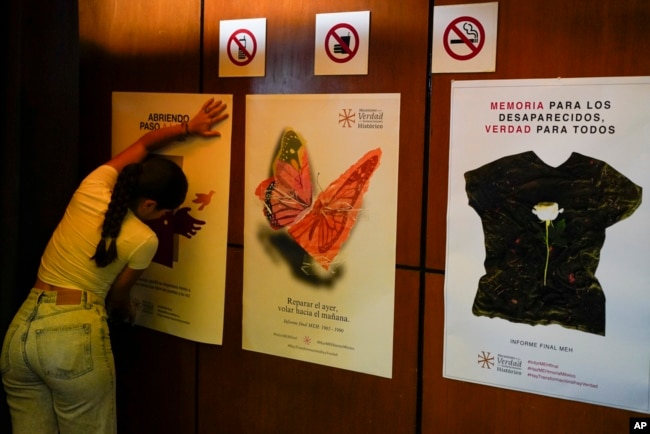Mexico's Dirty War
"The struggle to uncover the whole truth of Mexico’s Dirty War has been long and arduous. For years, the Mexican government maintained a policy of denial and obfuscation regarding its actions during this period.""It wasn’t until the early 2000s that significant efforts were made to investigate these crimes, leading to the establishment of the Special Prosecutor’s Office for Social and Political Movements of the Past (Femospp).""However, despite these efforts, justice has been slow, and many cases remain unresolved."The Latin American Post
 |
| Posters about missing people are placed on a wall for the presentation of a report about the country’s 1965-90 “dirty war” by Mexico's governmental Truth Commission in Mexico City, Aug. 16, 2024. |
Argentina's
infamous 1976-1983 military dictatorship and its well-earned reputation
of 'disappearing' its critics and political opponents is an
internationally recognized representation of the corrupting power of
such powerful groups in their victimization of populations whose human
rights have been regularly violated. The well-publicized horrors
undergone by Argentinians never knowing where their family members
suddenly disappeared to, and the sinister rumours of macabre death
missions when secret prisoners were disposed of by dumping their bodies
into the sea represented the stuff of nightmares.
Now,
though similar, but limited-scale, such operations that took place in
Mexico have long been rumoured and Mexicans called upon their
government, one administration after another, to investigate and finally
produce a true picture of what had occurred, to put to rest the agony
of families whose members had disappeared without trace. Finally a
governmental Truth Commission has done just that, revealing the scope of
the decades-long secret operation and the scope of its impact.
Mexico's
1965-1990 "dirty war" mystery is finally unravelling with emerging
evidence of Mexican authorities having disposed of dissident bodies. The
revelations by the country's governmental Truth Commission's report
relied on witnesses and documents that were leaked over the years which
detailed victims' chilling last moments in executions reflecting the
Mexican government's efforts to eliminate leftist and guerrilla
movements challenging the legitimacy of the military government.
 |
| A visitor looks at an exhibit during the inauguration of a memorial to victims of Mexico's "dirty war" at the former Federal Security headquarters where protesters were taken in 1971 following a violent crackdown in Mexico City, June 10, 2019. |
Apprehended individuals, as yet individually unidentified, one by one were directed to stand beside a bench at a military airfield located near Acapulco, believing their photographs were to be taken. Instead, each was shot in the back of the head, and their bodies disposed of by being dumped out in the Pacific Ocean by planes dispatched to that very specific government mission. Testimony given by a man who served in a military police unit of the time related that the gun used in the killings most often, was given a nickname: "the sword of justice".
It
is speculated that up to 1,500 victims met their end in this way,
though there is no way to be certain of numbers, much less the
identification of them as missing individuals. Another witness who
worked as a military aviation mechanic, described having taken part in
fifteen of the death flights. He spoke of female victims that were
offered release or that of their husbands dependent on their agreeing to
have sex with soldiers. None of them, to his recollection, had been
released.
Log
books for about 30 flights by one plane from the base between 1974 and
1979 were located by the truth commission. Another 25 flights were
claimed through another witness statement dating two decades in the
past, from a man claiming to have been an armed forces deserter. A list
of 183 names of likely victims of "death flights" had been held in the
possession of a deceased rights activist. Matches were found for people
who had disappeared during the counter-insurgency campaign led by the
government.
Small
rural guerrilla movements in Guerrero state where Acapulco is located
appear to have been the target. Swept up in the disappearances and
killings, a broad range of people were included; fishermen in the area
recalled seeing bodies wash up on shore. This obvious evidence of what
many had suspected led the military to begin placing the bodies in sacks
weighted with rocks, before disposing of them in the ocean.
These
are but a small part of details within the 4,000-page report whose
contents include executions, torture, disappearances and forced
displacement against farmers, students, union activists and members of
Indigenous groups, by the government.
The
truth commission cited evidence that there were roughly 4,500
identified victims of severe abuse during the "dirty war" in Mexico;
another 1,450 were documented as killed, while 517 were categorized as
disappeared with no trace. Excavations have been carried out by the
government, in and around military bases in recent years in an effort to
relocate remains of the buried in clandestine grave sites, realizing
scant success.
600 possible perpetrators of the abuses were asked by the commission to be investigated for involvement.

Labels: "Death Flights", "The Sword of Justice", Disappeared, Mexico's Truth Commission, Report

<< Home